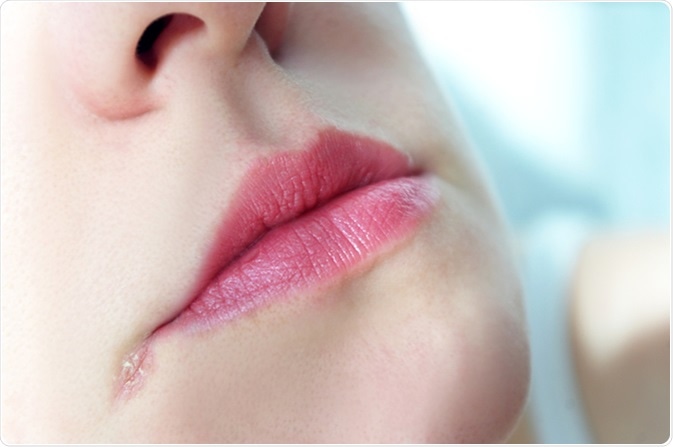Actinic cheilitis (AC), which is also referred to as sailor’s lip or farmer’s lip, is a condition in which the lips are damaged, particularly the vermilion border of the lip, as a result of extensive exposure to the sun. The lips of people with this condition appear dry, cracked, or chapped, and can also present with lesions or ulcers. Furthermore, the sharp vermilion border of the lip becomes blurred in individuals with AC.
Although it occurs in the upper lip, the lower lip is the most commonly affected area in AC. AC is more likely to arise in men as compared to women, and this condition predominantly affects Caucasians.

Image Credit: Cessna152 / Shutterstock.com
Why prevention?
Living with AC is extremely difficult. Many of the people affected with this condition experience constant irritation in the skin, which creates discomfort. There is also a chance for bacterial or fungal infection, as the lesions in the lips may bleed and develop ulcers.
Sometimes, permanent cicatrix may occur, as is the case with actinic keratosis. One of the major complications that can be developed due to AC is squamous cell carcinoma, which is a type of skin cancer that usually occurs as a result of delayed AC treatment or when the condition remains untreated.
Taking the appropriate precautionary measures is crucial to preventing AC, as this is a chronic and premalignant condition that can cause debilitating effects.
Preventive methods
The best prevention method against AC is to avoid prolonged and chronic sun exposure. If an individual cannot stay away from sun due to their profession, for example, it is important for them to incorporate certain protective components to their daily life. These measures can include the use of wide-brimmed hats and protective clothing, particularly when the intensity of sun exposure is at its maximum.
The use of sunscreens, such as lip balms having that offer high sun-protection factors and can aid in the prevention of actinic keratosis, can also assist in limiting an individual's vulnerability to AC. Frequent diagnosis by a physician should be done when an individual is regularly exposed to the sun or works in a sunny atmosphere.
Avoiding sun exposure
Spending time in the sun increases an individual's risk of skin cancer and premature skin aging. Persons of white skin color are mostly commonly affected by invisible ultraviolet (UV) radiations, particularly ultraviolet A and B (UVA and UVB, respectively). When the skin cells are damaged by UV rays, the growth rate of these cells can be altered, which subsequently can lead to the development of certain skin cancers and conditions like AC.
The skin cells can be protected from UV radiation by following the below practices:
- Avoid excessive sunbathing and roaming outside during spring and summer months, as the intensity of the UV rays are stronger during this time of year.
- Avoid staying out in the sun or limit sune exposure, especially between 10 a.m. to 2 p.m., as this time frame is when UV radiation from the sun is at its peak.
Use of sunscreen
The United States Food and Drug Administration (FDA) recommends that individuals use broad-spectrum sunscreen products that offer a sun protection factor (SPF) of 15 or higher to prevent damage from UVB rays. These sunscreen products can come various forms, some of which include lip balms, lotions, creams, sticks, gels, and sprays.
It is generally recommended that these sunscreen products are applied properly on uncovered skin, especially that of the nose, hands, and lips, at least every two hours. Although sunscreen will not completely block UV radiation, it will reduce the individual's risk of acquiring skin cancer or other skin conditions like AC.
Check immunosuppression
UV radiation can induce a variety of biological effects on an individual including premature skin aging, as well as reduced function of the skin’s immune system, which may increase the individual's risk of skin cancer.
In many ways, UV radiation can suppress the immune system. UV radiation stimulates the release of immunosuppressive cytokines, which can induce the generation of lymphocytes of the regulatory subtype and ultimately inhibit antigen presentation.
The major target source of UV radiation and subsequently the location the immunosuppression takes place is within the DNA molecule. More clarification on UV-induced immunosuppression will pave the way not only for better understanding of the effects of UV radiation, but also to frame new protective strategies.
Preventing actinic keratosis
Actinic keratosis or solar keratosis is also caused by excess sun exposure and can lead to AC. Retinoids are a well-known group of chemical compounds that include tretinoin, isotretinoin and retinaldehyde, to name a few. Many of these retinoids are broadly used for the prevention of non-melanoma skin cancers, especially actinic keratosis (AK). In fact, retinoids have successfully demonstrated their utility in preventing the development of new precancerous skin lesions and skin cancers.
These retinoids have anti-proliferative and anti-apoptotic properties, both of which regulate the growth of keratinocytes. To this end, retinoids can increase the expression of p53 and act as an antioxidant to reduce the number of sunburnt cells.
References
Further Reading
Last Updated: Mar 18, 2021